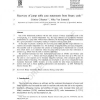Free Online Productivity Tools
i2Speak
i2Symbol
i2OCR
iTex2Img
iWeb2Print
iWeb2Shot
i2Type
iPdf2Split
iPdf2Merge
i2Bopomofo
i2Arabic
i2Style
i2Image
i2PDF
iLatex2Rtf
Sci2ools
IWPC
1999
IEEE
1999
IEEE
Recovery of Jump Table Case Statements from Binary Code
One of the fundamental problems with the static analysis of binary (executable) code is that7 of recognizing, in a machine-independent way, the target addresses of n-conditional branches implemented via a jump table. Without these addresses, the decoding of the machine instructions9 for a given procedure is incomplete, leading to imprecise analysis of the code. In this paper we present a technique for recovering jump tables and their target addresses in a11 machine and compiler independent way. The technique is based on slicing and copy propagation. The assembly code of a procedure that contains an indexed jump is transformed into a normal13 form which allows us to determine where the jump table is located and what information it contains (e.g. o sets from the table or absolute addresses).15 The presented technique has been implemented and tested on SPARC and Pentium code generated by C; C++, Fortran and Pascal compilers. Our tests show that up to 89% more of17 the code in a text segm...
| Added | 04 Aug 2010 |
| Updated | 04 Aug 2010 |
| Type | Conference |
| Year | 1999 |
| Where | IWPC |
| Authors | Cristina Cifuentes, Mike Van Emmerik |
Comments (0)

